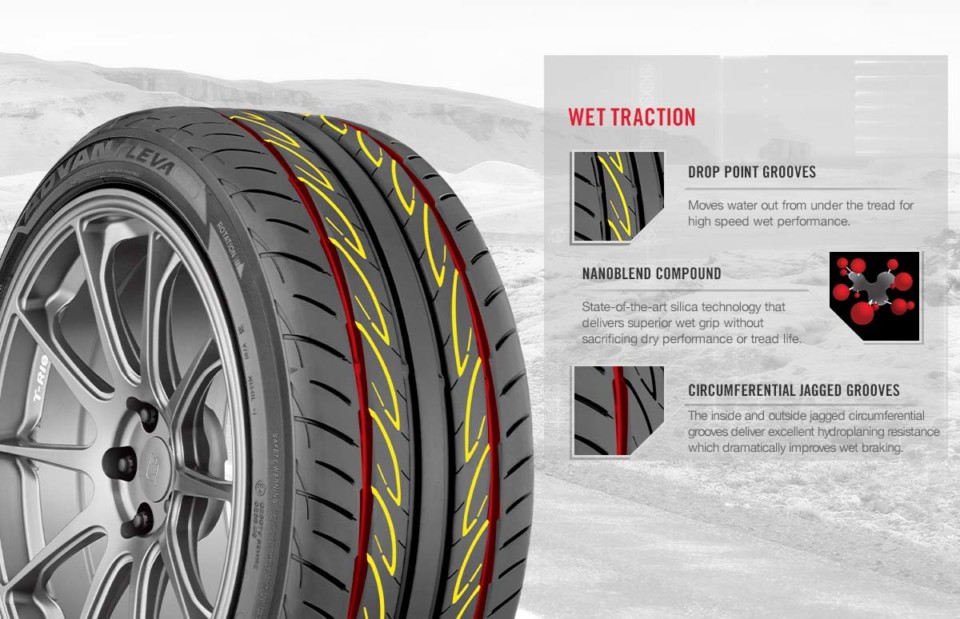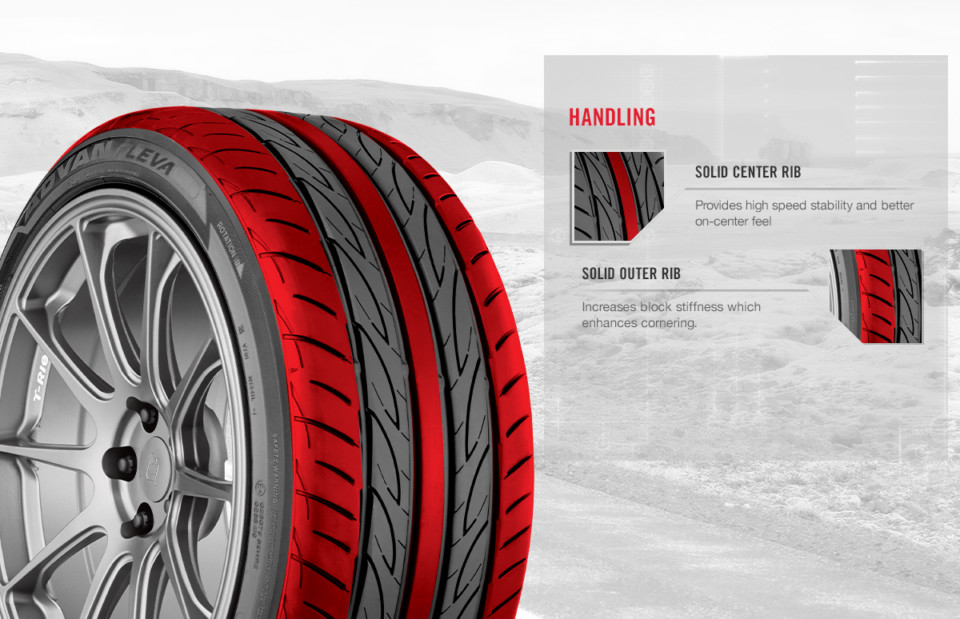The folks at Yokohama Tire Corporation were kind enough to send us a set of their new Yokohama ADVAN Fleva V701 tires for evaluation. The embedded video in this article provides feedback from our testing. However, there’s so much cool tech in this tire we need to spend a couple of paragraphs geeking out about them. Even if you’re not a tire geek, please follow along as we share a few insider tips on selecting tires that could be helpful to you in the future.
First, a word of warning: if you’re looking for a review of a track day tire, this isn’t it. What the ADVAN Fleva provides is exceptional handling, low noise, and long mileage for a vast range of vehicles (just check out the size range). It’s a great choice if your driving is limited to the street, a second car in the family, or even for on-road use when you switch from dedicated track tires like the ADVAN A052. Please continue.
First, it’s essential to know that tires aren’t just the product of rubber injected into a mold. There’s a great deal of ever-evolving technology in premium level tires like the ADVAN line, and the ADVAN Fleva V701 takes advantage of quite a few of them.
Tire Geek 101
To try to explain this as quick as possible, basically, all the ‘rubber’ elements (there’s not much natural rubber in tires today) are blended in a three-story Cuisinart called a Banbury mill. The ‘rubber’ is then moved to different locations in the factory and formed into its final shape. The tire is built from the inside out, starting with the main ply layers, inner liner, steel belts, steel-reinforcement (important in a performance tire as centrifugal force wants to pull the steel away from the tire), along with the bead wire and bead filler (the hard ‘rubber’ just above the bead that helps provide steering response and consistent cornering performance).
What a Shape!
We told you all of this so you can appreciate what Yokohama has done. Through its research and development, it has determined the best possible tire contour for the set of benefits that the ADVAN Fleva V701 is designed to offer. That was the easy part.
What they did then was reverse-engineer the shape back through the production process, so all the various elements that go together in the tire are appropriately sized. This way, when they come out of the ADVAN Fleva-specific mold, they feature the exact contour the engineers desire. The net result is the tire shape alone allows the ADVAN Fleva V701 to better distribute the pressure placed on it by your vehicle. In turn, this optimizes the contact patch for improved handling and braking as well as on-center steering response at highway speeds. Pretty cool, and we haven’t even gotten to the tread yet.
Where the Rubber Meets the Road
Speaking of the tread, the tread ‘rubber’ formulation is actually quite complex. Not surprising, given the ADVAN Fleva V701 is a premium-level product. An advanced, nanoBLEND compound combines wear-resistant and high-fuel efficiency polymers with silica and orange oil to provide high levels of dry and wet traction, along with extended wear and fuel efficiency.
Designing Treads
The tread design on the tire serves one purpose — to evacuate water from beneath the tire to reduce the risk of hydroplaning. Anyone who has watched a race in person or on television knows that on a sunny day, slick tires are fitted to all race classes that allow them. If you were able to drive around with a pit crew in your car who could jump out and change your vehicle over from slick tires to rain tires when the first drops hit your windshield, you wouldn’t need a tire with a tread design most of the time. But like seat belts, they are there because you’ll never know when you need them.
Racing rain tires are the ultimate expression of a tire designer’s skill in developing a pattern that moves water quickly from the area of the contact patch. But, those tires would howl if you drove them on the highway. There’s no consideration for noise levels or driver comfort. So, the tire engineers must create a tread design that works well in moving water but still provides a quiet ride on dry roads. Not an easy compromise.
In the Yokohama ADVAN Fleva V701, there are multiple technologies at work to address wet traction and hydroplaning resistance.
How Fast is Your Water?
At first look, you’ll recognize a prevalent design for an ultra-high performance tire: a solid center rib with two adjacent straight circumferential grooves. But, move out to the next set of grooves. They’re not straight like the grooves in the middle, but rather have jagged grooves. The reason is due to hydrodynamics and laminar flow.
Basically, water follows a straight (laminar) flow at lower velocities, but as the speed of the water increases, turbulence increases as well. That slows the water, making it harder for the tire to evacuate that area. With the jagged grooves, the water is redirected into a more laminar flow, speeding water under the tire.
Drop Point Grooves
These are the fishhook looking grooves you’ll find in the intermediate ribs of the tire (a tread design is broken down into center rib, intermediate ribs, and shoulder ribs). The shape might look slightly familiar to you, especially if you’ve been shopping for brake rotors recently.
Virtually the same shape appears on some racing and ultra-high performance rotors for much of the same reason as you see them on the ADVAN Fleva V701. They provide a large void area for wet traction while having a limited effect on the stiffness of that tread rib. On a brake rotor, instead of drilling holes or slotting the rotors to remove gases and debris, the same shape is used with little impact on the strength of the rotor.
Move to the Shoulder
Take a close look at the shoulder or outer and inner ribs. You’ll notice that none of them are unsupported blocks. Each features a diagonal groove, but they alternate between small grooves that stand-alone and more substantial, extended grooves that fully connect to the sides of the tread. But, they have only a tiny, reinforced slot between them and the circumferential groove. This is done to provide water evacuation while marinating a stiff shoulder area for performance handling.
Handling the Dry
These larger, well-supported shoulder blocks are the area in which your tire (and your car) lean when going through a turn. So the more substantial and stiffer the block, the better the handling response. And it’s not just a measure of g-force, but rather that of providing the driver with a consistent handling tire upon which they can rely.
As much as we’d dream otherwise, for most of us, the majority of what we drive on are straight roads. So straight-ahead handling and steering response are essential elements to that type of driving. The Yokohama ADVAN Fleva V701 addresses those needs through its solid center rib, which is always in contact with the road surface to provide traction and quick steering response.
And in Conclusion
If you’ve read the article, watch the video. If you’ve watched the video, read the article. If you do both, you’ll have a clear picture of what the ADVAN Fleva V701 is all about. There are not many tires where you’ll have as clear of a description of its design, development, and advantages as provided here for the Yokohama Fleva V701.
























